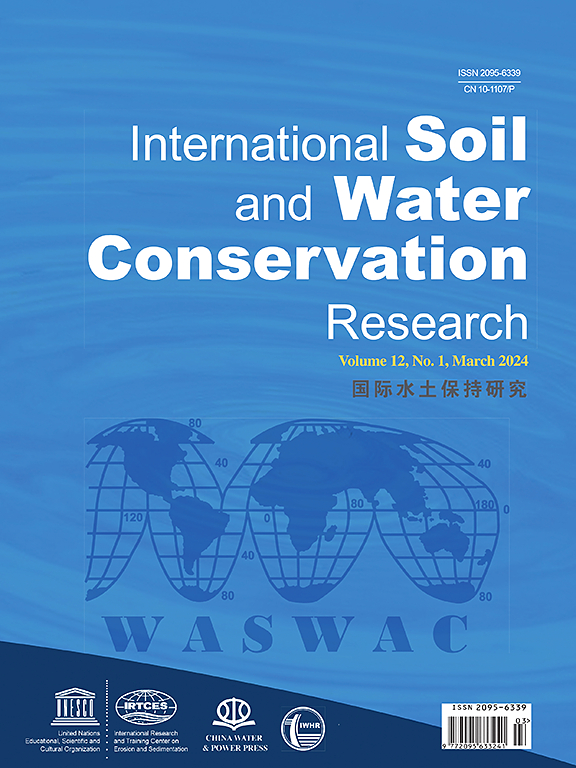热带森林的森林恢复恢复了表层土壤的保水能力,但没有改善深层土壤
IF 7.3
1区 农林科学
Q1 ENVIRONMENTAL SCIENCES
International Soil and Water Conservation Research
Pub Date : 2025-05-09
DOI:10.1016/j.iswcr.2025.05.002
引用次数: 0
摘要
近十年来,由于刀耕火种,热带原始森林迅速减少,导致在不同恢复阶段形成热带次生林。但是,次生林的土壤保水能力能否恢复到原生林的水平,目前还不清楚。本研究选取海南岛热带森林的三个恢复阶段(恢复早期、恢复中期、恢复后期)和原生林进行比较。采用时空替代法,研究了不同恢复阶段和原生林土壤持水量的变化规律,揭示了其主导控制因素。结果表明:随着恢复阶段的推进,0 ~ 60 cm土壤保水能力增强。其中,表层土壤(0 ~ 10 cm)后期保水基本可以恢复原生林的水平,而深层土壤(10 ~ 60 cm)随着恢复阶段的推进,保水可能无法恢复原生林的水平。此外,随着恢复阶段的进展,土壤结构和土壤养分也有所改善,土壤团聚体稳定性降低。其中,总孔隙度是控制土壤保水的最重要因素,占27.44%,其次是容重(19.62%)和毛管孔隙度(16.83%),而土壤粒度组成对土壤保水的影响较弱。综上所述,森林恢复是提高表层土壤保水能力的有效措施,但深层土壤保水能力可能需要较长时间才能恢复。这些发现对原始森林的管理和保留以及次生林的恢复具有启示意义。本文章由计算机程序翻译,如有差异,请以英文原文为准。
Forest restoration in tropical forests recovers topsoil water retention but does not improve deep soil layers
Tropical primary forests have been rapidly reduced in recent decade owing to slash-and-burn, leading to the formation of tropical secondary forests in different recovery stages. However, it is still unclear whether the soil water retention capacity in secondary forests can recover to the level of soil water retention in old-growth forest. In this study, three recovery stages of tropical secondary forests (i.e. early recovery stage, middle recovery stage, late recovery stage), and old-growth forest were selected for comparison in tropical forests on Hainan Island. By using spatiotemporal substitution method, we investigated the variation of soil water retention in three recovery stages and old-growth forest, and revealed its dominant controlling factors. The results showed that 0–60 cm soil water retention was improved as recovery stage progresses. Specifically, the topsoil (0–10 cm) soil water retention in later stage almost could recover the level of old-growth forest, whereas the deep soil (10–60 cm) water retention may not recover the level of old-growth forest as recovery stage progresses. Additionally, the soil structure and soil nutrients also improve while the soil aggregates stability reduced as recovery stage progresses. Among these properties, total porosity was found to be the most important factor controlling soil water retention, accounting for 27.44 %, followed by bulk density (19.62 %) and capillary porosity (16.83 %), but soil particle size composition had a weakly effect on soil water retention. Overall, our results suggested that forest restoration is effective measures improve topsoil water retention capacity, but the deep soil water retention capacity may need more years to recovery. These findings have implications for the management and retention of primary forests and the restoration of secondary forests.
求助全文
通过发布文献求助,成功后即可免费获取论文全文。
去求助
来源期刊

International Soil and Water Conservation Research
Agricultural and Biological Sciences-Agronomy and Crop Science
CiteScore
12.00
自引率
3.10%
发文量
171
审稿时长
49 days
期刊介绍:
The International Soil and Water Conservation Research (ISWCR), the official journal of World Association of Soil and Water Conservation (WASWAC) http://www.waswac.org, is a multidisciplinary journal of soil and water conservation research, practice, policy, and perspectives. It aims to disseminate new knowledge and promote the practice of soil and water conservation.
The scope of International Soil and Water Conservation Research includes research, strategies, and technologies for prediction, prevention, and protection of soil and water resources. It deals with identification, characterization, and modeling; dynamic monitoring and evaluation; assessment and management of conservation practice and creation and implementation of quality standards.
Examples of appropriate topical areas include (but are not limited to):
• Conservation models, tools, and technologies
• Conservation agricultural
• Soil health resources, indicators, assessment, and management
• Land degradation
• Sustainable development
• Soil erosion and its control
• Soil erosion processes
• Water resources assessment and management
• Watershed management
• Soil erosion models
• Literature review on topics related soil and water conservation research
 求助内容:
求助内容: 应助结果提醒方式:
应助结果提醒方式:


